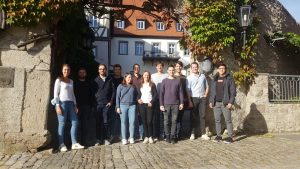In order to be able to address research in the two future topics of robotics and medical technology in a more targeted manner and to communicate this to the outside world, the strongly occupied research area of biomechatronics will be split up. At the joint strategy meeting from September 30 – October 1, 2021 in Frickenhausen, Franconia, the topics were delineated from one another and connecting synergies were discussed.
In the newly created research area of medical technology, applications for people as individuals and the improvement of their quality of life are researched and developed. For this purpose, the manifold engineering competences of the chair, for example in the fields of robotics, image recognition or additive manufacturing, are transferred to medicine with its special requirements.
In addition to the development of automation solutions, especially in the context of medical robotics, the research of innovative therapy and assistance systems is a focus of the research area. In this field, not only the mechatronic implementation and integration are researched, but also more advanced questions, such as the recording of biomedical parameters or self-sufficient energy supply solutions are addressed. In addition, innovative manufacturing processes for medical technology represent a research focus. Here, the focus is on optimizing additive manufacturing and qualifying novel biocompatible materials for it. Digitization solutions are also a future topic in medical technology. In addition to digital process optimization and the development of digital systems, model building for the digital twin of the human being is a focus of the research area’s activities.
The new robotics research area has the core task of contributing to the further development of robotics. For this purpose, novel hardware and software components as well as frameworks are investigated in an integrated approach, which in interaction open up new application fields for robot systems. In terms of hardware, research is being carried out on compliant actuators and sensors, among other things, which, together with classical components, serve to build new types of kinematics as handling systems, movement apparatuses and interaction partners. In addition, safe control architectures are being developed in order to be able to operate mobile and stationary robots in different environments in accordance with standards. Here, in addition to investigating technical aspects such as safe sensor data fusion, participation in processes for developing new standards and guidelines also plays an important role. For different fields of application, technologies for autonomous systems continue to be developed and efficiently combined with intervention options by users in order to be able to operate, debug and train systems via teleoperation. In different research projects, all kinds of robotic systems are thus investigated, not only to realize versatile and highly accurate applications in industrial scenarios, but also to enable the use of novel service robots in professional environments and to create cost-efficient assistance systems for the private sector.

